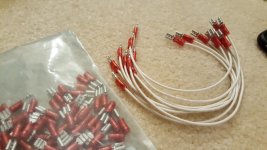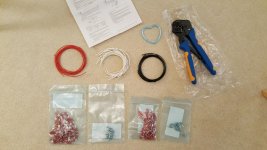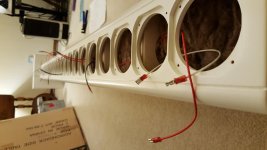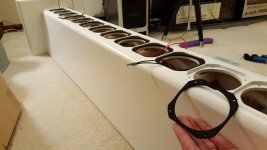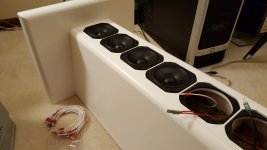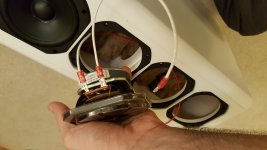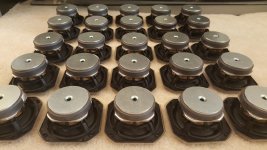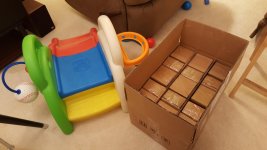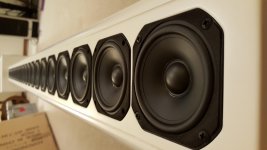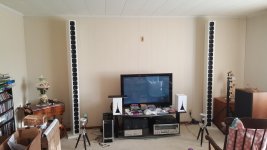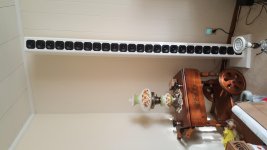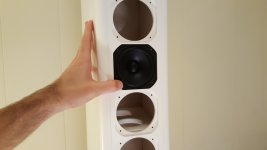I chose not to solder the wiring as I'm too new to it. Instead I chose to use a quality crimping tool with quick disconnects that match the die set in the crimper. The crimper from TE Connectivity was $120 but completely worth it.
Attachments
Nice! Did your guy do those cabinets by hand, or are the baffles and such done on a CNC router? Also, where did you find drivers for $1 each??? I’m about to start designing some for myself, and the pain of $10 x 50 ea has got me a little bummed. $50 for 50 drivers would be super.
You mentioned in your post that you are experienced in woodworking and sculpture. Were you planning to stick with Roger Russell's cabinet design or create your own. I can't wait to see what you do!
I found that the cabinet was the most expensive part of my build ($1800) but I hired someone to build mine.
Phantom Center Image
A few posts ago I was struggling with getting a center image from the arrays. I've had great experience with point source speaker after placement, toe-in, and light rake. I had tried tow-in with the arrays and still didn't have center imaging. Don't get me wrong, they sounded amazing.
I figured it out. I had to toe them in further to around 45 degrees (which I find extreme) and I finally have it!
A few posts ago I was struggling with getting a center image from the arrays. I've had great experience with point source speaker after placement, toe-in, and light rake. I had tried tow-in with the arrays and still didn't have center imaging. Don't get me wrong, they sounded amazing.
I figured it out. I had to toe them in further to around 45 degrees (which I find extreme) and I finally have it!
The arrays setup.
Cool, and now you can use those mini-ks for surround duty.
You saw those, did you!!! I built those to try out the TC9's. They put out a surprisingly full sound.
May I ask how you EQed your arrays? It's a huge learning curve for me and my computer sound card keeps going into limiting with barely any volume. I plan to get a miniDSP with Dirac. Any opinions on this?
May I ask how you EQed your arrays? It's a huge learning curve for me and my computer sound card keeps going into limiting with barely any volume. I plan to get a miniDSP with Dirac. Any opinions on this?
What's your computer sound card?
In a PC, there are a bunch of add-ons that you have to turn off.
Depending on your OS version, there are a number of posts online to make the most out of a PC and perform better as an audio machine.
Google "optimizing PC for audio" and add your PC OS.
Follow the guides.
As for playback, do you follow the trend of JRiver or Foobar?
A miniDSP (HD!) with Dirac is a one click solution. It does some stuff without you being involved too much, besides adding your own FR curve target. That's it. Point the mic, make measurements, and sit back. You may or may not enjoy the result.
Also, Dirac is a $200 premium.
Free is DRCDesigner. Wesayso has extensive coverage about DRC. The simple way is to have the Dirac way with DRCDesigner gui and just measure, choose your FR curve, choose the amount of processing and input the convolution file into JRiver or Foobar. Adjust to taste.
Then, look up the convolution guide made by Gmad, available here at DIYAudio.
He's got a number of presets to try.
So, REW, DRC, a mic and some time to come up with a sound you will have more control of, but it comes in as more work... it's not just point, click and enjoy.
In a PC, there are a bunch of add-ons that you have to turn off.
Depending on your OS version, there are a number of posts online to make the most out of a PC and perform better as an audio machine.
Google "optimizing PC for audio" and add your PC OS.
Follow the guides.
As for playback, do you follow the trend of JRiver or Foobar?
A miniDSP (HD!) with Dirac is a one click solution. It does some stuff without you being involved too much, besides adding your own FR curve target. That's it. Point the mic, make measurements, and sit back. You may or may not enjoy the result.
Also, Dirac is a $200 premium.
Free is DRCDesigner. Wesayso has extensive coverage about DRC. The simple way is to have the Dirac way with DRCDesigner gui and just measure, choose your FR curve, choose the amount of processing and input the convolution file into JRiver or Foobar. Adjust to taste.
Then, look up the convolution guide made by Gmad, available here at DIYAudio.
He's got a number of presets to try.
So, REW, DRC, a mic and some time to come up with a sound you will have more control of, but it comes in as more work... it's not just point, click and enjoy.
Funny... I didn't know that company, yet they are based in Taiwan! 
I have the miniDSP HD 2x4. It is a good unit. Cheap enough.
It allows you to do PEQ, crossover should you want to add a sub or two, and to even get further, it has FIR filters (a bit limited in taps) to manage EQ and phase.
Use the digital output of your CD player into the miniDSP. It really keeps the sound cleaner than if you do the extra conversion by using the analogue inputs.
And if you add the Dirac like you want, you wouldn't need a computer to play your music.
Myself, I have been won over by high Res music files, and the convenience of all my music based on a hard drive. No need to get up and change the CD! Geez, I'm so lazy now! And to think that not so long ago, we had to get up after 5 songs to flip the vinyl!
I have the miniDSP HD 2x4. It is a good unit. Cheap enough.
It allows you to do PEQ, crossover should you want to add a sub or two, and to even get further, it has FIR filters (a bit limited in taps) to manage EQ and phase.
Use the digital output of your CD player into the miniDSP. It really keeps the sound cleaner than if you do the extra conversion by using the analogue inputs.
And if you add the Dirac like you want, you wouldn't need a computer to play your music.
Myself, I have been won over by high Res music files, and the convenience of all my music based on a hard drive. No need to get up and change the CD! Geez, I'm so lazy now! And to think that not so long ago, we had to get up after 5 songs to flip the vinyl!
You mentioned in your post that you are experienced in woodworking and sculpture. Were you planning to stick with Roger Russell's cabinet design or create your own. I can't wait to see what you do!
I found that the cabinet was the most expensive part of my build ($1800) but I hired someone to build mine.
I'm not sure yet. I'm waiting on drivers, but will start making 3D models in the mean time. I'm torn between simple and plain, and thinking about this as an opportunity to build something crazy. I want them to sound good above all else, and possible decoration/design work that looks interesting may hurt sound quality. I'll probably build the simple box as proof of concept, and make the main baffle removable so that I can reuse it if I choose to make something more visually appealing. The cost of doing the router is paying for time and experience. Usually making the drawings/models takes longer than the actual cutting.
I don't think he could have flush mount the drivers without the CNC machine.
It can be done, but it's a miserable job to get right. very easy to make mistakes and need to start from the beginning.
I have the miniDSP HD 2x4. It is a good unit. Cheap enough.
It allows you to do PEQ, crossover should you want to add a sub or two, and to even get further, it has FIR filters (a bit limited in taps) to manage EQ and phase.
And if you add the Dirac like you want, you wouldn't need a computer to play your music.
Myself, I have been won over by high Res music files, and the convenience of all my music based on a hard drive. No need to get up and change the CD! Geez, I'm so lazy now! And to think that not so long ago, we had to get up after 5 songs to flip the vinyl!
Between the miniDSP 2x4 HD and the version with Dirac, is the added price worth the time savings. I have been following Wesayso's post for the last ~5 years. Most of that has been adjusting filtering. As much as I want to learn this stuff, $200 seems pretty cheap as far as time savings.
Can I use the Dirac unit simply as a 2x4HD if I decide I don't like Dirac?
I used to have all my music on the computer and I kept skipping around to different tracks. I never sat down and listened to one thing. I treat my cds like vinyl.
It can be done, but it's a miserable job to get right. very easy to make mistakes and need to start from the beginning.
With mine, there is a slight gap between each driver that is fragile because of the flush mounting. When prototyping it, I could break it off with my fingers. Doing it by hand, that part might break off.
Flush mounting, for me, was well worth it for aesthetics and hopefully helps with difraction. You all would have to tell me if that actually works at reducing diffraction though.
Attachments
I'm not sure yet. I'm waiting on drivers, but will start making 3D models in the mean time. I'm torn between simple and plain, and thinking about this as an opportunity to build something crazy. I want them to sound good above all else, and possible decoration/design work that looks interesting may hurt sound quality. I'll probably build the simple box as proof of concept, and make the main baffle removable so that I can reuse it if I choose to make something more visually appealing. The cost of doing the router is paying for time and experience. Usually making the drawings/models takes longer than the actual cutting.
What drivers did you order?
I'm still struggling with getting them "tuned right" but I would say that they are the best speakers I have ever had. I felt that they were worth doing right, cabinet and driver wise as I plan to use them for the next 40 years.
I look back at the test cabinets I was trying to build 5 years ago and am glad that I did it right this time.
I don't know what building something "crazy" means to you but I really want to see you do it!
I'm not sure yet. I'm waiting on drivers
Make sure to ask for a quote on bulk purchasing and possibly price matching with a competitor. My driver cost came down 39% from the list price by doing that.
I don't know what building something "crazy" means to you but I really want to see you do it!
I'd say mine were pretty crazy to build
I must say you did a fine job with these. Very neat, clear and the white color does seem to hide them a bit better than my "flashy" setup.
I see you have a couple of questions. First one was about imaging... you did find a solution with toe-in. The more interesting thing would be to see how this setup with that ~45 degree toe-in measures at the listening position compared to the previous position. Then we start to learn something from it
I can guess, but that's no good. Seeing the differences brings us more usable data. Basic imaging is getting the left and right clean in the first few milliseconds and have the same balance left and right. The longer your reflection free zone becomes, the stronger and more clear/precise the imaging becomes. But you've got to know what you want. When I took all the early reflections out, some of the excitement the arrays used to have disappeared too.
That all came back in spades with the introduction of the ambient speakers, but hey, you might want to keep it simpler and just stop a bit sooner than I did. A little room isn't necessarily a bad thing. I "made" me a room that is fully adjustable. Again, the work of a lunatic. I had planned to try that ambient setup as far back as 2011.
As you know everything I play, I play from disk. I wouldn't have it any other way anymore. Though I do have fond memories spinning my vinyl and CD's to start my weekend. Maybe some day I'll go back to that. Right now convenience has taken over and a seemingly endless library at your disposal does have it's charms.
I have no experience with the MiniDSP, but have seen more than a few Dirac results. The thing that would bug me most is that it is closed processing.
You either like the result or you don't.
I have spend a lot of time on processing, as you know. But it wasn't due to a specific need to do that for such a long time. It was due to me, wanting to learn more about it all. (I say more, I meant everything)
I'm still at it, as I've created a play garden for myself to do fun experiments, by first getting an optimum room/speaker integration. The big steps of setting something up aren't that time consuming. It is trying to go from good to great that takes a lot of time. And I continue to push my perception or reference of great up higher!
I certainly can imagine a lot of people wanting something far more simple than what I run today. What can I say, I'm just a nut that likes to get to the bottom of everything. Find the how and why's of it all.
The thing I'd miss the most by going to a sealed box setup like MiniDSP or similar is the huge numbers of tabs I can use in my DSP processing. More room for me to play with. On top of that I get to play with audio-routing and have multiple channels at my disposal.
So I cannot help you much there. I don't know what it is yet, to have such restrictions.
P.S. it is a good thing I have a family
Last edited:
- Home
- Loudspeakers
- Full Range
- Obtaining my White Whale (25 Driver IDS-25 Line Array Build)
